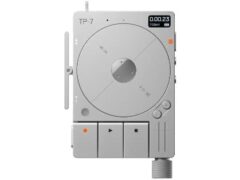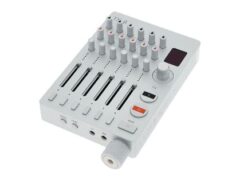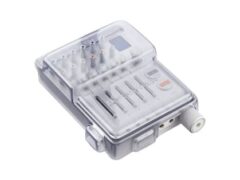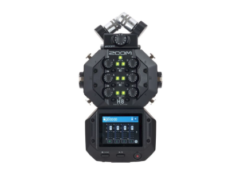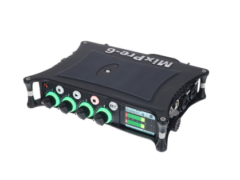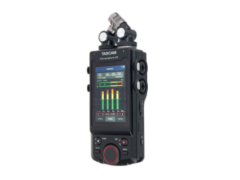The TP-7: A Promising Portable Recorder with Noteworthy Features, but at a Premium Price.
Teenage Engineering, known for their innovative pocket-sized drum machines and synthesizers like the Pocket Operator range and the flagship OP-1, has consistently focused on merging portability and functionality with a strong emphasis on design aesthetic.
The TP-7, a newly unveiled portable recorder, aims to challenge the notion of portable recording. Boasting impressive features and a compact design, does the TP-7 have the potential to revolutionize portable audio recording?
Teenage Engineering's latest addition to the field range, the TP-7, carries the prestigious "Made for Apple" badge, indicating its compatibility with Apple products and suggesting it would find a comfortable spot in Apple Stores, one of the few physical retail locations where it will likely be sold.
We got to interview Teenage Engineering at Superbooth, and had the opportunity to get a firsthand look at the TP-7 and understand the buzz surrounding it. The company explained that the device targets a broad range of users, including interviewers, podcasters, field recorders, musicians, journalists, and even doctors.
However, the wide scope of its intended applications raises questions about whether the TP-7 might be trying to cater to too many different markets, and with its relatively high price point, we can't help but wonder if they are pricing themselves out of the very market they claim to be aiming for, namely lone musicians recording on the go.
Features
Undeniably, the TP-7 boasts an appealing aesthetic with its sleek design and compact form factor. Despite its small size, it manages to pack in an array of features.
In addition to the main output for speakers or headphones and the built-in microphone, the TP-7 offers three 3.5mm stereo connections that can serve as inputs or outputs. These connections can be configured for mono, balanced mono, or stereo, enabling users to utilize them for microphone inputs, line I/O, or additional headphone and speaker outputs.
We see no reason why the TP-7 can't act as a 6-input recorder, albeit with the channels set to stereo mode and splitter cables used on each input, and when combined with the TX-6 mixer via USB-C, can be expanded further and becomes a 9 input stereo recorder (or 18 mono).
The TP-7 supports 24-bit/96 kHz recording, enabling high-resolution audio capture and playback, and the inclusion of Bluetooth connectivity allows for seamless wireless integration with compatible devices.
We have to also mention the app which comes bundled with the recorder and makes it easy to connect a smartphone and transcribe your interview/podcast.
Expandability
As part of the field range, the TP-7 is designed to work with the CM-15 condenser microphone, which has it's own phantom power, and is connectable via USB-C leaving the other 3 inputs or outputs available for other sources.
Phantom power is also available and can be sent to any of the 3.5mm outputs, but as there is space for the 6.35mm TRS output it would have been nice to see a mini-XLR connector here too, to mitigate the danger of accidentally 'hot-plugging' a microphone and damaging the device in the process.
In terms of storage capacity, the TP-7 features a 128GB internal hard drive, which may initially appear limited. However, when recording in 96/24 uncompressed format, this capacity allows for approximately 20.5 hours of stereo recording time using all three inputs simultaneously.
Even at 44.1/24, there is enough space for approximately 45 hours of recording before reaching the drive's maximum capacity.
Whilst direct recording to an external drive isn't supported, the internal storage should prove sufficient for most recording scenarios, and with a battery life of around 7 hours, users will most probably run out of power before filling up the drive space.
Beyond its technical features, the TP-7 offers some interesting tactile elements. For instance, it incorporates a spinning disk motor that can be used to halt recording or even become a miniature turntable/DJ setup when combined with another TP-7 and the mixer. It includes a "side rocker" for audio scrubbing, (a term simply referring to the navigation of audio files - just in case you were wondering), as well as the more traditional play, stop, and record buttons for intuitive operation.
Alternatives
While Teenage Engineering argues that using a smartphone to record interviews and capture song ideas presents various barriers to efficient recording, it is crucial to pause and breathe for second or two before we all empty our bank accounts. Smartphones are capable of performing many of the same functions as the TP-7 and are already sitting in our pockets. Therefore, the additional expense associated with the TP-7 as a "scrap-book" recorder may dissuade potential buyers, instead opting for a more cost-effective smartphone solution to lay down ideas when inspiration hits.
In light of the TP-7's price and the availability of alternatives, there are quite a few options. For instance, the Zoom H8 offers a significantly cheaper alternative for portable recording, featuring 6 XLR inputs, a touchscreen interface, and up to 512GB SD card recording capacity.
The Zoom H8 offers a maximum recording quality of 24-bit/96kHz and includes an XYH-6 microphone capsule, with the ability to use exchangeable clip-on microphones and an optional ambisonic capsule.
It provides four XLR mic inputs, two mic/line/instrument inputs, and expandable mic/line inputs via additional modules. The H8 also functions as a 12-channel and stereo audio interface and supports various recording formats. Whilst not as compact as the TP-7, the Zoom H8 provides versatile input options and is expandable, and at just under €400 makes a compelling alternative for portable recording needs.
Tascam also have a contender in this range with the Portacapture X8, an 8-channel recorder with touchscreen, built in mixer and effects, an 11 hour battery life and the ability to be controlled via Bluetooth when purchasing the optional Tascam AK-BT1 for a mere €33 extra. Unlike the Zoom H8 the Tascam is able to record 192khz/32bit audio resolution.
In a similar price range to the TP-7, the Zoom F8n Pro and Sound Devices Mix-Pre 6 II both provide professional-grade field recording capabilities with multiple connection options, supporting resolutions of up to 192khz/32bit audio recordings in a rugged chassis designed for the field.
When comparing the TP-7 and the Mix-Pre 6 II, there are several key differences. Whilst the TP-7 offers a total of three stereo inputs/outputs, the Mix-Pre 6 provides eight tracks, consisting of a stereo mix and six single XLR inputs, furthermore it has an impressive maximum recording quality of 92khz/32bit float and a dynamic range of 142 dB indicating superior audio performance to the TP-7. Both are controllable remotely, with the MIx-Pre controllable via the Wingman mobile app.
While the Mix-Pre offers versatility in its power options, including the use of 4 x AA batteries, there is a notable drawback in its compatibility with longer-lasting Sony-style NP-F960 batteries. An expensive adapter is required and in our opinion should never have gotten past quality control, particularly for a field recorder.
Even the slightest weight of the battery, causes the adapter to continuously un-clip, rendering it impractical and unreliable in real-world scenarios.
With that said, the MP-6 is an exceptional quality recorder and is cheaper than the TP-7 at around €1350.
Unfortunately, at the time of writing this we have no information on the TP-7's microphone preamp specifications, and so are unable to make a comparison there. Additionally we have no information on AD/DA convertor specification.
Conclusion
While the TP-7 places a strong emphasis on its sleek and compact design, there are other audio recorders available on the market that offer a wider range of features and capabilities. These alternative options provide higher recording resolution and greater input options without the need for costly expansions.
Thanks to it's minimalist 'Dieter Rams'-esque design, the TP-7 has an aesthetic quality which is bound to put it in high demand, and it's probably the only portable recorder you are able to show off as an accessory.
Given the premium price point and additional investment required for expansion this should limit its appeal to a more niche audience, but this is Teenage Engineering we are talking about, who like Apple seem to dictate the market rather than settle to find their place within it.
Check out the full interview from Superbooth, available above.
